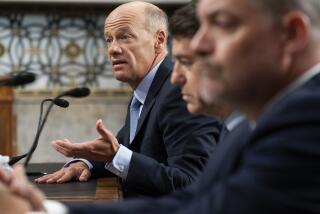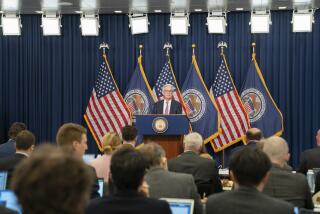Lawmaker Says S&L; Buyers Got 78-to-1 Return : Thrifts: House Banking Committee Chairman Henry B. Gonzalez says the selloff of some institutions in 1988 amounted to “virtual giveaways.”
- Share via
WASHINGTON — The investors who bought insolvent savings and loan institutions in the government’s frenetic selloff in 1988 received $78 in assets and tax benefits for every $1 in capital they invested, House Banking Committee Chairman Henry B. Gonzalez (D-Tex.) said Thursday, calling many of the transactions “virtual giveaways.”
Gonzalez predicted that investigations by his committee and government agencies will force the Bush Administration “to renegotiate, if not cancel,” many of the 1988 transactions.
The Banking Committee inquiry is uncovering “giveaways and costs certain to trigger strong public outrage,” Gonzalez said.
Federal regulators rushed to complete the sales of insolvent S&Ls; in the waning days of 1988, aware that tax benefits for potential buyers would be curtailed at year’s end.
The regulators were faced with a growing list of insolvent S&Ls; and--with the deposit insurance fund virtually exhausted--they lacked the money to shut the institutions and pay off depositors, whose accounts were protected up to $100,000.
The regulators working at the Federal Home Loan Bank Board adopted a policy of selling when possible, offering attractive incentives to private investors who would take over the crippled S&Ls.; Investor Robert Bass bought American Savings & Loan, a massive $16-billion institution in Stockton, for $410 million.
The Banking Committee will hold hearings next month on the 1988 sales, using the American Savings deal as one of its case studies.
The haste of the sales was criticized at the time. However, Congress rejected efforts to cancel the deals when it prepared the S&L; rescue legislation last year.
But the controversy surrounding the 1988 deals has a new life, prompted by the rising cost of the thrift cleanup. The Administration now calculates it will cost $90 billion to $130 billion, without counting future interest expenses on bonds to pay for closing hundreds of defunct S&Ls.;
Multiple investigations are under way to determine whether the 1988 transactions were excessively generous for the private investors who pumped badly needed capital into the S&Ls.; Two Congressional probes are taking place, along with a study by the General Accounting Office. The Resolution Trust Corp., the new federal agency charged with disposing of ailing S&Ls;, is also conducting an investigation.
Many of the 1988 sales “are economically unsound on their face, and it is impossible to believe that the interests of the government and the taxpayers could not have been better protected,” Gonzalez said. “We realize the agency was strapped for cash and that failed savings and loans were continuing to drain the insurance fund, but these factors do not explain away all the shortcomings that are now so evident in these contracts.
“A rash of deals earlier in the year--of the magnitude of the December sales--almost certainly would have raised public concern about the growing savings and loan crisis. Instead, the public got the bad news as part of its New Year’s hangover.”
The House Banking Committee studied 94 deals and determined that investors contributed $2.2 billion in capital and received assets and benefits worth a total $175.5 billion.
The benefits include $66.9 billion in guarantees, assurances that the government will reimburse the buyers of the S&Ls; for future losses on the assets, including loans and real estate, they have acquired. The buyers also get $4.2 billion in federal tax breaks.
The transactions are “honeycombed with guarantees extending into the future, assuring many of the investors a risk-free future courtesy of their friendly federal government,” Gonzalez said.
Sen. Howard Metzenbaum (D-Ohio) has been conducting hearings on the 1988 sales, including the sale of an S&L; to a man previously barred from the insurance business in Alabama. Metzenbaum contacted senior officials of some of the nation’s leading law firms, who indicated their willingness to represent the government in efforts to renegotiate the transactions. If the government accepted their aid, the law firms would be willing to work on a contingency basis, waiving their usual advance retainers, and accepting a share of any funds they recovered.
Gonzalez acknowledged that altering the 1988 contracts could involve “monumental legal and financial problems.” But he said it is an imperative task. “I urge the Bush Administration to take a very hard look at each of these contracts, level with the American public about the 1988 giveaways and make the hard decisions now,” he said.
More to Read
Inside the business of entertainment
The Wide Shot brings you news, analysis and insights on everything from streaming wars to production — and what it all means for the future.
You may occasionally receive promotional content from the Los Angeles Times.










